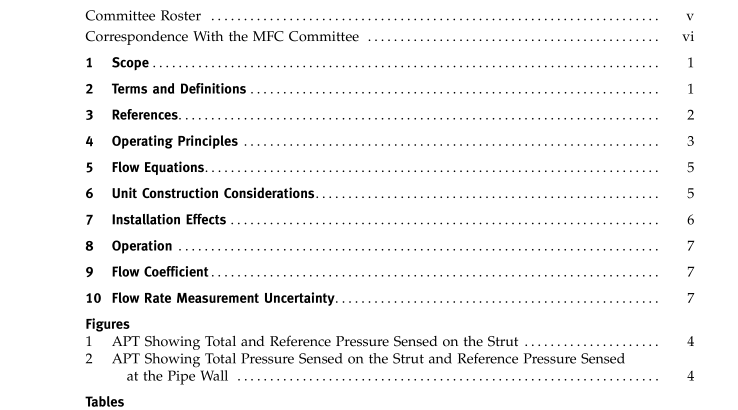ASME MFC-12M-2006 pdf free download.Measurement of Fluid Flow in Closed Conduits Using Multiport Averaging Pitot Primary Elements
6.4 Hot Taps When considering hot/wet tap elements, the manu- facturer shall perform the structural calculations and provide flow rates or signal limits for the following two conditions: (a) when the sensor is not in contact with the opposite side of the pipe (b) when the sensor is not in contact with the opposite side of the pipe, while being inserted or retracted from the closed conduit
6.5 Materials In addition to the requirement that the materials of construction are compatible with the system process fluid, they must be compatible with the method of con- struction. When dissimilar metals are used, selection should be such that galvanic corrosion is not induced to the extent that the performance and life of the device is impaired. Selection of the materials of construction must also consider atmospheric corrosion when hostile atmospheres are present.
6.6 Structural Consideration The system must provide structural integrity with respect to pressure, temperature, induced bending due to fluid drag, expansion due to thermal effects, and any other impressed loads. In addition, fluid mechanical forces caused by the fluid flowing past the sensing ele- ment may cause the sensor to vibrate. This vibration can affect the performance of the meter and could result in fatigue failure of the sensor. Consult the manufacturer for appropriate flow rate or signal limits for the specified sensor size, design, and pipe size.
7 INSTALLATION EFFECTS
The primary element performance can be affected by installation and velocity profile. Deviations in the velocityprofile canbe caused byin-line equipment, the piping configuration, and disturbances upstream and downtream of the primary element. The manufacturer’s performance specifications should include a statement of the reference conditions under which the flow coefficient and uncertainties were determined. APTs can be used to measure flow rate for gas or liquid in horizontal and vertical installations. In liquid flow applications the flow direction should be upwards to help ensure a full pipe for flow measurement. The pressure head difference, in vertical flows, should be zeroed out with the secondary during installation and startup.7.1 Velocity Profile Manufacturers define the performance of their APT for reference profile conditions with specific upstream and downstream lengths of straight pipe. These lengths are chosen to ensure the performance of the APT. Under nonreference conditions, upstream velocity profiles may affect the velocity profile at the flow measurement point and influence the performance. The manufacturer should be consulted for the sensitivity of the APT to nonreference flow conditions. In some cases, the use of a flow conditioner may restore the velocity profile to the reference profile.
7.2 Upstream and Downstream Pipe Length Requirements The minimum upstream and downstream straight lengths ofpipe required to meetthe performance specifi- cation of the APT should be stated by the manufacturer. The minimum lengths required downstream of different pipe fittings may vary for each APT and piping configuration. When the flow measurement application or installa- tion configuration does not match one of the manufac- turer’s listed applications and installations, the flowmeter manufacturer should be consulted. If the manufacturer cannotprovide sufficientguidance, in-situ calibration may be considered. In-situ calibration establishes the flow coefficient of the APT and uncertainty under actual operating condi- tions. If in-situ calibration is performed, the calibration should be done in accordance with acceptable standards as listed in section 3. If in-situ calibration is not possible, the effect of installation can be reduced by performing a flow laboratory calibration of the meter replicating the actual upstream and downstream piping installations.
7.3 Alignment and Orientation
7.3.1 Alignment. The manufacturer shall specify the limits of the allowable angular tolerances for the installation of the APT. Deviation of the APT primary element in any angular alignment from the allowable limits can result in erroneous flow measurement.
7.3.2 Orientation. Manufacturers shall specify pre- ferred APT locations and orientations with respect to the horizontal or vertical axis of the flow conduit. These preferred orientations may depend on the fluid being measured.ASME MFC-12M pdf download.ASME MFC-12M-2006 pdf free download
